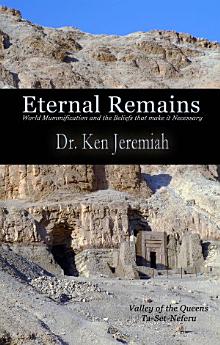Eternal Remains: World Mummification and the Beliefs that make it Necessary
About this ebook
make it Necessary provides an overview of mummification, but it concentrates on
the reasons behind the act. It
investigates the justification for preserving dead bodies, and in so doing,
probes the true nature of both life and death.
Many think of these as two distinct concepts, like day
and night, but they are not distinct.
Day fades into night, and night then returns to day. There are realms in which night and day
merge, such as dusk and dawn. Perhaps
the relationship between life and death is similar.
After explaining the natural processes of decay and how
they are halted, various mummies in different parts of the world are
introduced. In the Americas, these
include snow- and ice-preserved bodies in Montana and Alaska, and some
controversial finds in other states. The
Guanajuato mummies in Mexico and the strangely-preserved bodies in San
Bernardo, Columbia are also introduced, alongside new translations of modern
reactions to such bodies. The
mummification techniques of cultures in Central and South America are also
delineated, including Incan sacrificial ceremonies and the preservation of
Incan kings. Unusual preservations in
South America include the Chancay practice of turning the deceased into drums,
which were played during special ceremonies, and the Jívaro method of shrinking
heads.
In addition, Eternal Remains introduces to the
English-speaking world the recently discovered world's smallest mummy,
Ichiknuna. Chapters about European
mummies cover the so-called Frankenstein mummies of Cladh Hallan and
fantastically preserved bog bodies, which provide evidence of ancient murders
and superstitious customs. The mummies
in Ferentillo, a small town north of Rome in the region of Umbria, were
strangely preserved by the soil's chemical composition.
Eternal Remains contains many pictures of these mummies,
which have not been previously published.
It also provides new information about what happened to King
Tutankhamen's body after it had been embalmed and placed into a sarcophagus,
and it explains the amazing discovery of cocaine, nicotine, and hashish in nine
different 7,000-year-old Egyptian mummies.
Since mainstream historical understanding holds that
these substances only existed in the Americas at the time, the discovery is
forcing some scholars to consider the possibility of cross-oceanic trade, which
would force a historical rewrite. Other
controversial finds are likewise presented in this text, including the
discovery of advanced, ancient Caucasian bodies in China.
This book is one of few in English to cover Buddhist
mummification in Tibet and China, and the amazingly self-mummified monks in
Japan. Newly translated information
about some of these monks, never before published in English, is included in
this book, alongside pictures of the monks who engaged in this suicidal
practice. Eternal Remains also explains
modern methods of conservation. The
reasons behind the worldwide desire to mummify are similar, and by
investigating the techniques and the underlying beliefs that necessitated the
practice, one can more clearly see just what makes us human. This study forces readers to reflect upon the
true nature of life and death, and connections are made between the spiritual
portion of each individual and other natural phenomena. They are led to ponder the ultimate
significance of it all.
The final conclusions formed are sure to inspire all,
providing a new way to consider death and its relationship to life. Eternal Remains combines a study of
mummification with comparative religions, and an analysis of worldwide beliefs
about the nature of death. It will open
one's eyes to new possibilities concerning human advancement, anomalous
archaeological discoveries, and the greatest mysteries of both life and death.
Ratings and reviews
- Flag inappropriate
About the author
Ken Jeremiah has written extensively about history, religion, and critical thinking. His previous books include Remnants of a Distant Past, Christian Mummification, Living Buddhas, Aikido Ground Fighting, and If the Samurai Played Golf...Zen Strategies for a Winning Game. He teaches world language and comparative religion courses, and currently resides in Narragansett, RI.






